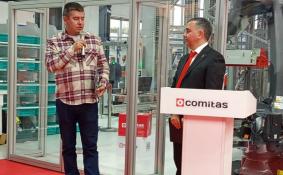Scientific & Practical Journal

Editorial News
Dear readers! We are pleased to present to you the eleventh issue of the journal in 2025. There are a lot of relevant and useful materials in the issue, which, hopefully, will not be ignored.
Dear readers! In September the CeMAT RUSSIA exhibition was held, which showed everyone that innovations and robotics are increasingly penetrating the logistics industry. We can safely say that many technologies are tested here, and only then they go out into the world. However, it is not only CeMAT RUSSIA that demonstrates the prevalence of the digital agenda.
Dear readers! This is the ninth issue of the journal, which turned out to be very rich and diverse. Traditionally, the issue is opened by an analyst. The material by Alina Nasyrova from the Market Guide Agency, dedicated to investments in warehouse complexes in Russia, recalls the importance of developing logistics infrastructure for the integrated development of regions.
PHOTO OF THE WEEK
CITATIONS
All News of Logistics
GEFCO Launches First Carbon-Neutral Block Train on the New Silk Road
On November 15, 2021, a 41-wagon block train will depart on a three-week journey from Dunajska Strada Slovakia to Xi’an China on the New Silk Road. This block train is GEFCO’s first carbon-neutral train operated for a customer seeking low-carbon transportation solutions for consumer goods. GEFCO will offset the 250 tons of CO2 generated from this door-to-door service by investing in Gold Standard certified projects. In addition, the train will be equipped Internet of Things (IoT) devices to guarantee track and trace, temperature control and product integrity during transit.
Alice Defranoux, Rail Manager at GEFCO, commented: “We are pleased to partner with our longstanding customer to provide this milestone carbon-neutral train. Market demand is increasing for more climate-friendly solutions, especially in long-distance transportation. At GEFCO, we calculate the environmental impact of our solutions, re-engineer them to minimize emissions and propose offsetting solutions for any remaining carbon. Rail is a very good way to achieve reduced carbon emissions.”
The three-week journey on the New Silk Road includes travel from Slovakia to Brest- Małaszewicze at the Polish-Belorussian border, where the goods will be transferred from European to Russian rail wagons to adapt to the 1.52m rail gauge. The block train will then travel through Belarus and Russia and arrive at Alashankou-Dostyk in Kazakhstan, a major link in the Eurasian Land Bridge on the border with Xinjiang, the port of entry into China. The goods will then be loaded on Chinese wagons before their final delivery in Xi’an.












